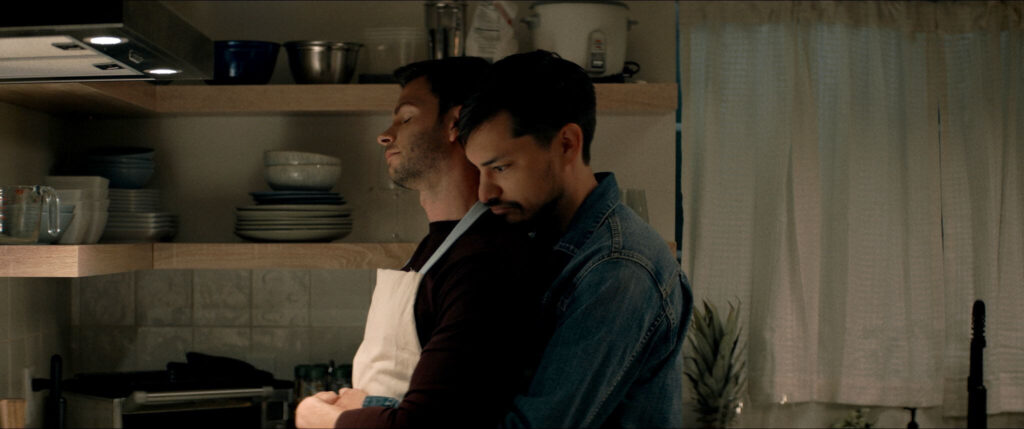By Gary M. Kramer | Read Original Article

Out gay writer/director Addison Heimann makes an auspicious feature directorial debut with “Hypochondriac,” a queer horror film “based on a real breakdown” he himself experienced.
The film opens with Will (Ian Inigo as a child) nearly being killed by his mother (Marlene Forte) when she is having mental health issues. 18 years later, Will (Zach Villa as an adult) starts having his own issues when he gets messages from his mother, who may be out of the psych ward. Will’s stress jeopardizes his own mental and physical health, as well as his relationship with Luke (Devon Graye), his boyfriend of 8 months.
Heimann conveys Will’s breakdown stylishly with images that show his hallucinations — some involve him seeing a wolf — as well as more vivid, physical harm that Will inflicts on himself. He is aided by Villa’s remarkable performance as Will, a man who cannot control his inner fears. The filmmaker spoke with Gay City News about making “Hypochondriac.”
What prompted you to channel your story into a film?
I feel that people know so much about me now — things that probably, in real life, I wouldn’t tell other people. But now it’s on screen! When I decided to write the script, I was mentally broken down. What is the type of thing I want to make? I ultimately decided on telling stories that are queer, explore mental health, and have a genre lens.
Given this is a personal film, how did you work with Zach Villa on portraying you/Will?
I think the biggest benefit was that we spent a year together. I cast him in July 2020, but we didn’t shoot until June 2021. By the time we got on set, his interpretation to me was not offensive or off-putting or out there. It was very nuanced. He put in the work, and we formed a shorthand, so I was dialing knobs up and down, but very small. It was easy because the part fit him like a glove. He had to do some serious de-shedding after, because my story is very rough, and we put him through the ringer.
There are strong, visceral images as well as voices and sharp sound effects (stretching fingers) that heighten the intensity and the dread. Can you talk about depicting the trauma in a way that gut-punches viewers?
It was a blessing and a curse that I had to make a story about the mental breakdown. The real story is I lost functioning of my arms for six months because of an injury at work. Google was telling me I was dying of ALS, and my mother was leaving me voice mails telling me not to trust my friends. A confluence of events caused me to crack. The best way to [depict] that is an emotional retelling. It doesn’t matter what is real or what is not real. What you are experiencing is real to the person experiencing these things. That makes it horrific, because what you are battling is your brain — and that’s terrifying.
We did a lot of heavy lifting in principle photography, using different camera lenses and [created] distortion depending on what level of insanity there was. We had two “insanity meters.” One for the audience to see what is real and not real, and one for what was actually real and not real. We used that in the editing and sound design, so we knew how insane it should feel and how it should be in real life. That helped everyone see my vision.
What decisions did you make about Will’s episodes — what triggered them, how they would impact him and how you would present them?
In real life, my mother would send me these voice mails and no matter what, I would listen to them. I don’t know why. I was afraid she would show up at my doorstop. I cut her out of my life because she was a trigger. Will is haunted by this wolf, which is obviously representative of childhood trauma. The wolf will always be there, but if you tame it, you can move forward and have a relatively healthy life. Before that, Will has to get through his own triggers — his arm injury, and his mother leaving voicemails. The more he ignores it, the less reality he has to latch onto.
What observations do you have about how LGBTQ folks deal with mental health issues? Will’s sexuality is not necessarily the reason for his panic attacks, but he also has difficulty sharing his truth with his partner. He tries to do right by Luke but self-sabotages. His self-destructive qualities were quite telling.
I think there was a time and a place where it was important for people in the LGBT community that identity was the number one [issue]. But we’ve grown to the point that there is so much more nuance as identity grows. It’s not the number one thing on my call sheet. I don’t lead with that. [Sexuality] is one part of my life, and if you look at the film through a queer lens, you can see the queer aspects — the way Will interacts with his mother and father. But I’m not telling those [coming out/family] stories. I want to have queer representation in genre films, independent of sexuality.
You have this sweet romantic sequence at a cabin Will and Luke go to for a restful getaway that is really chaste, but then you have this really intense sex scene later when Luke helps Will, who has an episode. Can you talk about that?
That was the craziest scene insanity-wise in the movie. It starts out sweet and subtle and grounded, and then it turned into nightmare. Sex is important to me, and we need more full-frontal [nudity] in cinema. The film called for it because it is Will at his lowest. He is so destroyed, and he needs someone to feel good and [wants] to be fucked, but that is not what he needs; he’s chasing the wrong dragon. He needs to be in a hospital. But he thinks if gets fucked he can distract himself, and while it hasn’t worked yet, maybe it will work this time. That’s when the walls start to creep in; that is his downfall. He’s not facing things head on. He spirals further and further.
“Hypochondriac” | Directed by Addison Heimann | Opening July 29 in Theaters and August 4 on Demand | Distributed by XYZ Films
